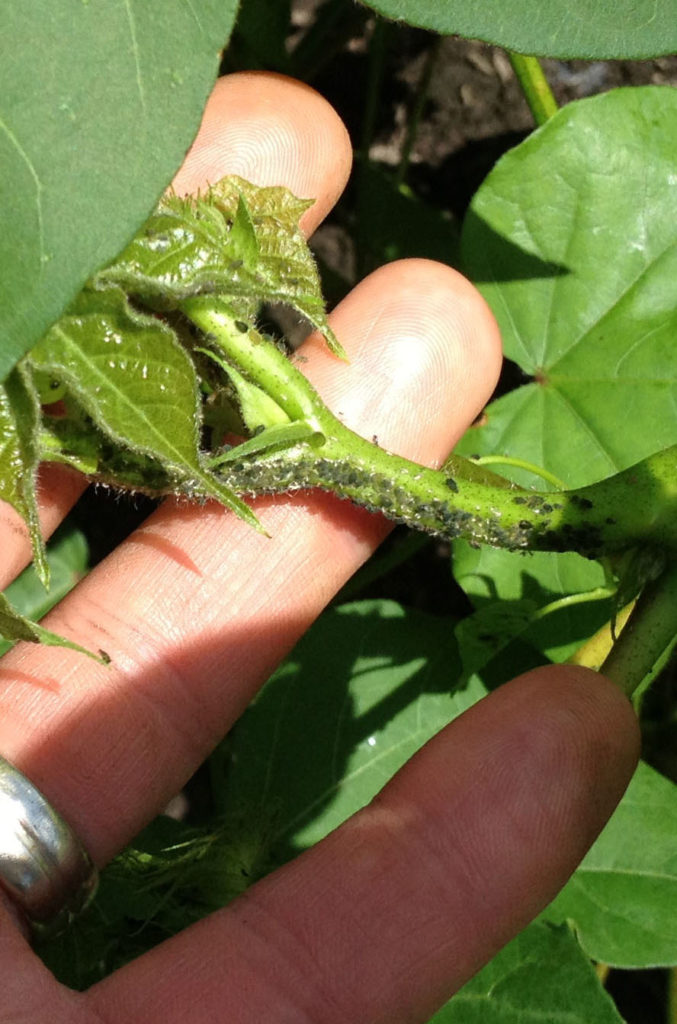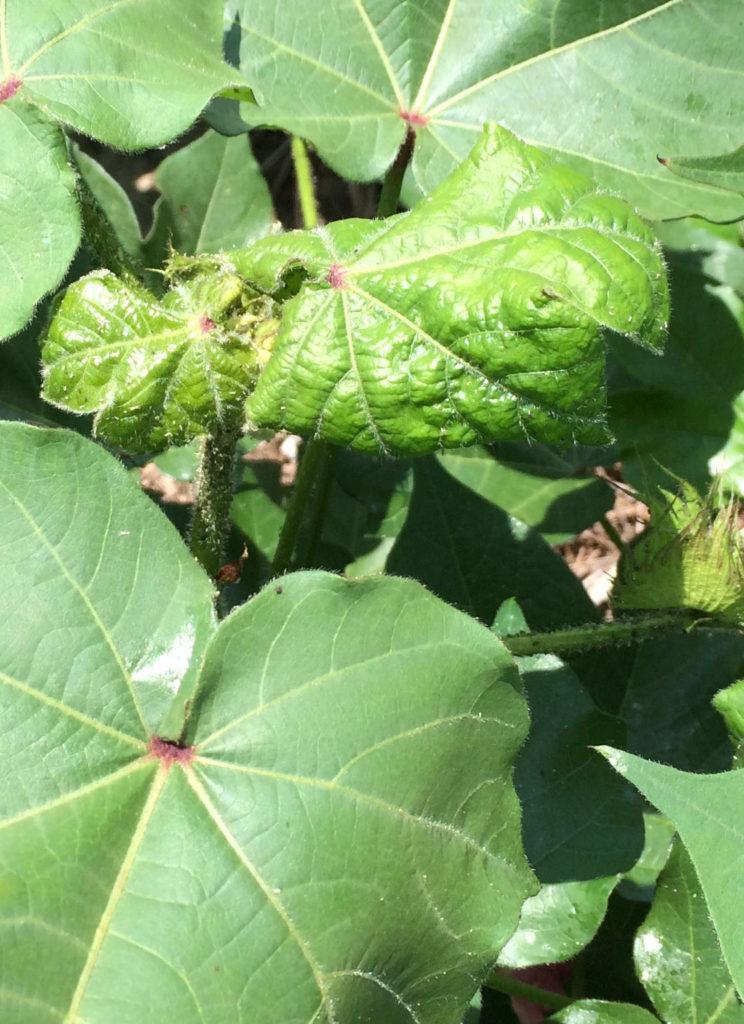Cotton Aphid
go.ncsu.edu/readext?646314
en Español / em Português
El inglés es el idioma de control de esta página. En la medida en que haya algún conflicto entre la traducción al inglés y la traducción, el inglés prevalece.
Al hacer clic en el enlace de traducción se activa un servicio de traducción gratuito para convertir la página al español. Al igual que con cualquier traducción por Internet, la conversión no es sensible al contexto y puede que no traduzca el texto en su significado original. NC State Extension no garantiza la exactitud del texto traducido. Por favor, tenga en cuenta que algunas aplicaciones y/o servicios pueden no funcionar como se espera cuando se traducen.
Português
Inglês é o idioma de controle desta página. Na medida que haja algum conflito entre o texto original em Inglês e a tradução, o Inglês prevalece.
Ao clicar no link de tradução, um serviço gratuito de tradução será ativado para converter a página para o Português. Como em qualquer tradução pela internet, a conversão não é sensivel ao contexto e pode não ocorrer a tradução para o significado orginal. O serviço de Extensão da Carolina do Norte (NC State Extension) não garante a exatidão do texto traduzido. Por favor, observe que algumas funções ou serviços podem não funcionar como esperado após a tradução.
English
English is the controlling language of this page. To the extent there is any conflict between the English text and the translation, English controls.
Clicking on the translation link activates a free translation service to convert the page to Spanish. As with any Internet translation, the conversion is not context-sensitive and may not translate the text to its original meaning. NC State Extension does not guarantee the accuracy of the translated text. Please note that some applications and/or services may not function as expected when translated.
Collapse ▲ Aphids are usually considered a minor economic problem in North Carolina. However, from ~1 to 9% of the state’s cotton acreage has been treated annually during the past decade. Cotton aphids usually occur in clusters or colonies around the terminal stems or under leaves. Their feeding cause young leaves to curl downward. Aphids excrete a sticky shiny substance called honeydew, which can cover lower leaves. Later in the season honeydew can fall into opening bolls and support a fungus called sooty mold, which may stain the lint and reduce its grade. Finally, aphids are a vector of cotton leaf roll dwarf virus (CLRDV).
Aphids are usually considered a minor economic problem in North Carolina. However, from ~1 to 9% of the state’s cotton acreage has been treated annually during the past decade. Cotton aphids usually occur in clusters or colonies around the terminal stems or under leaves. Their feeding cause young leaves to curl downward. Aphids excrete a sticky shiny substance called honeydew, which can cover lower leaves. Later in the season honeydew can fall into opening bolls and support a fungus called sooty mold, which may stain the lint and reduce its grade. Finally, aphids are a vector of cotton leaf roll dwarf virus (CLRDV).
 There are many reasons why insecticide treatments are rarely justified for aphids: 1) North Carolina aphids are resistant to organophosphate and neonicotinoid insecticides so more expensive insecticides must be used; 2) beneficial insects and fungi typically hold cotton aphids to low levels; 3) the yield impacts of CLRDV are unclear; 4) insecticides do not reduce incidence of CLRDV; 5) based on extensive fall damage surveys, aphid colonies in opening cotton have been almost nonexistent in North Carolina from 1985 to the present; and 6) honeydew deposited on lint is often washed away by rain before sooty mold can develop. Spraying for cotton aphids is recommended only when extremely high infestations, coupled with stressed cotton plants, are present throughout much of the field and there is little evidence of predators (i.e., lady bird beetles and their larvae or green lacewing larvae), the brownish aphid mummies, or the moldy-looking, parasitic fungus, Neozygites fresenii.
There are many reasons why insecticide treatments are rarely justified for aphids: 1) North Carolina aphids are resistant to organophosphate and neonicotinoid insecticides so more expensive insecticides must be used; 2) beneficial insects and fungi typically hold cotton aphids to low levels; 3) the yield impacts of CLRDV are unclear; 4) insecticides do not reduce incidence of CLRDV; 5) based on extensive fall damage surveys, aphid colonies in opening cotton have been almost nonexistent in North Carolina from 1985 to the present; and 6) honeydew deposited on lint is often washed away by rain before sooty mold can develop. Spraying for cotton aphids is recommended only when extremely high infestations, coupled with stressed cotton plants, are present throughout much of the field and there is little evidence of predators (i.e., lady bird beetles and their larvae or green lacewing larvae), the brownish aphid mummies, or the moldy-looking, parasitic fungus, Neozygites fresenii.
Because economic loss from aphids is very rare, scouting for aphids and their symptoms does not take on the same urgency as does scouting for pests such as bollworms. However, because moderate to high populations of cotton aphids can be potentially damaging, routine scouting for other pests should include notes on aphid levels.
Cotton Aphid Thresholds
Treat at a rating of 4 (shown below) in opening cotton (15 percent open bolls or greater) or a rating of 5 in pre-opening cotton if plants are under stress and beneficial insects and fungi are at low levels.
Treatment is discouraged under most circumstances if predators and/or parasites appear to be exerting a significant controlling effect on aphid populations, or if the aphid parasitic fungus is present at any level. In opening cotton, treat only if plants are heavily infested and honeydew is detected in significant portions of the field.
The aphid rating scale may help define situations where treatment for aphids may be indicated. In North Carolina, cotton aphid populations in a given area may be resistant to most commercially labeled insecticides.
Aphid Rating Scale
0. No aphids.
1. Occasional plants with low numbers of aphids.
2. Plants with low numbers common; heavily infested plants rare; honeydew visible occasionally.
3. Most plants with some aphids; occasional plants heavily infested; honeydew visible in spots throughout the field.
4. Heavily infested plants common; aphids clumped on upper leaves; honeydew present in much of the field.
5. Many heavily infested plants and honeydew throughout the field.


